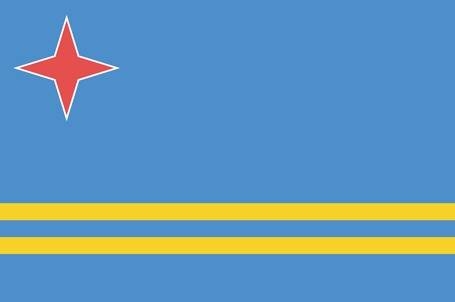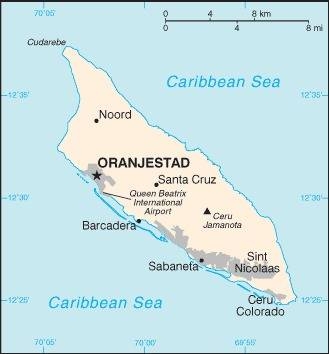96 Aruba (Netherlands)

Blue, with two narrow, horizontal, yellow stripes across the lower portion and a red, four-pointed star outlined in white in the upper hoist-side corner. The star represents Aruba and its red soil and white beaches, its four points the four major languages (Papiamento, Dutch, Spanish, English) as well as the four points of a compass, to indicate that its inhabitants come from all over the world. The blue symbolizes Caribbean waters and skies. The stripes represent the island’s two main “industries”: the flow of tourists to the sun-drenched beaches and the flow of minerals from the earth.
Flag courtesy of the CIA World Factbook

Map courtesy of the CIA World Factbook

East shore near Budi.
Photo courtesy of the CIA World Factbook
Last updated on October 27, 2025
Government
According to Britannica, a governor, appointed to a six-year term by the Dutch crown, is the formal head of government and representative of the reigning monarch of the Netherlands. Executive authority is vested in a Council of Ministers, headed by a prime minister. The council is responsible to a 21-member unicameral legislature, the Staten (States), elected by universal adult suffrage.
Department of Civil Aviation (DCA)
Aruba together with the Netherlands, Curaçao and Sint Maarten constitutes the Kingdom of the Netherlands, and therefore shares in the collective ICAO membership of the Kingdom of the Netherlands. In 1986 Aruba attained an autonomous state within the Kingdom and the Department of Civil Aviation (DCA) Aruba was founded. Firstly, the aviation laws of the Netherlands Antilles were adopted, afterwards amended and synchronized with the Dutch aviation laws. In 1995 major changes were made in the regulation in order to meet the level of the new European Joint Aviation Requirements (JAR-OPS, JAR-FCL, etc.). By meeting these requirements Aruba received high scores in the US DOT (FAA) audit, this resulted in an IASA-category 1 listing. These extensive efforts ensured for a thorough safety culture with several aviation authorities in Aruba. The aviation authorities and the local aviation industry have focused on the achievement of and to operate with the highest standards. A lot of time is spend and research done, taking into account the size of the island and the changing requirements, to meet these high requirements as well as the continuous promotion of the aviation industry in Aruba. An example of this is entering into agreements with other civil aviation authorities to share expertise.
Airspace
SkyVector – Google Maps – ADS-B Exchange
ICAO countries publish an Aeronautical Information Publication (AIP). This document is divided into three parts: General (GEN), En Route (ENR) and Aerodromes (AD). ENR 1.4 details the types of airspace classes they chose to adopt from classes A through G.
Drone Regulations
Advanced Air Mobility (AAM) Regulations & Policies
None found by the author.
However, should you, the reader, happen to stumble across something to the contrary, please email the author at FISHE5CA@erau.edu and you may be mentioned in the ACKNOWLEDGEMENTS section of this book by way of thanks for contributing to this free eBook!
Advanced Air Mobility (AAM) News
None found by the author.
However, should you, the reader, happen to stumble across something to the contrary, please email the author at FISHE5CA@erau.edu and you may be mentioned in the ACKNOWLEDGEMENTS section of this book by way of thanks for contributing to this free eBook!
Short Essay Questions
Scenario-Based Question
You have been hired by a Drone Startup Company. Your boss has immediately assigned this job to you.
They need you to prepare a one-page memo detailing the legalities of using a drone to film in Budi, pictured above.
They need you to mention any national laws and local ordinances.
They specifically want to know what airspace (insert pictures) you will be operating in and whether or not you need an airspace authorization.
Does it matter whether or not you are a citizen of the country?
Lastly, there is a bonus for you if, as you scroll through this chapter, you find any typos or broken links!
Short Essay Questions
- What are the drone categories?
- How is registration addressed?
- How is remote ID addressed?
- What are the model aircraft rules?
- What are the commercial drone rules?
- Are there waivers or exemptions to the rules? If so, for what?
- Would you share a link to an interactive airspace map?
- How is BVLOS addressed?
- How can you fly drones at night?
- How can you fly drones over people?
- Where do you find drone NOTAMs?
- What are the rules for drone maintenance?
- What are the rules for an SMS program?
- What are some unique rules not mentioned above?
- What are the C-UAS rules?
- What are the AAM rules?

